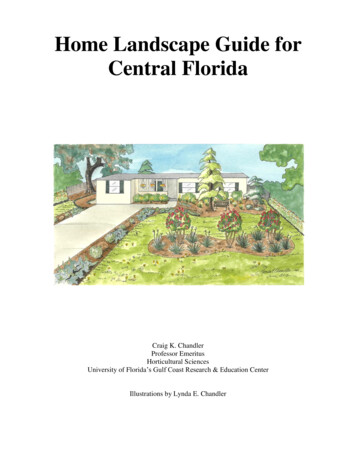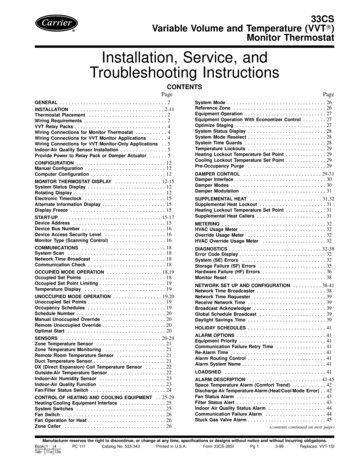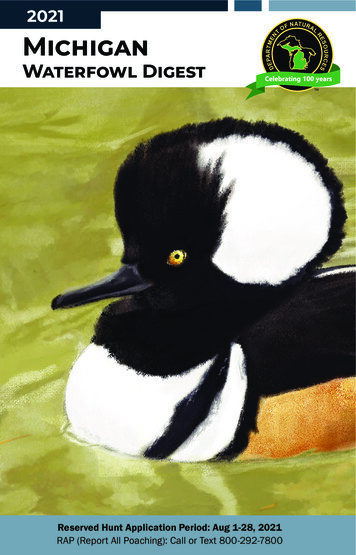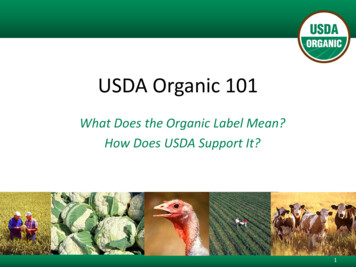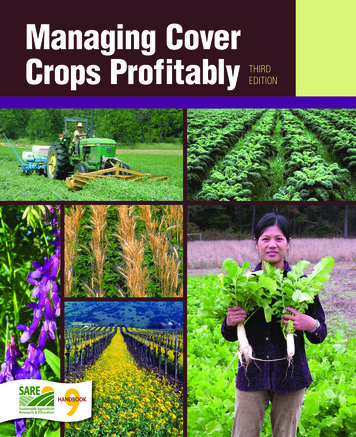
Transcription
Agricultural Research Service USDAUSDA Plant Hardiness Zone Map
Managing CoverCrops ProfitablyTHIRD EDITIONHandbook Series Book 9Published by the Sustainable Agriculture Research and Education(SARE) program, with funding from the National Institute ofFood and Agriculture, U.S. Department of Agriculture
Third Printing - June 2012Library of Congress Cataloging-in-Publication DataManaging Cover Crops Profitably, Third Edition, was published in 2007 by the Sustainable Agriculture Research andEducation (SARE) program under cooperative agreementswith the National Institute of Food and Agriculture, USDA,the University of Maryland and the University of Vermont.Managing cover crops profitably / project manager andeditor, Andy Clark.—3rd ed.p. cm. -- (Sustainable Agriculture Research and Education(SARE) program handbook series ; bk. 9)Includes bibliographical references and index.ISBN 978-1-888626-12-4 (pbk.)1. Cover crops—United States—Handbooks, manuals, etc.I. Clark, Andy. II. Sustainable Agriculture Research &Education (SARE) programEvery effort has been made to make this book as accurate aspossible and to educate the reader. This text is only a guide,however, and should be used in conjunction with other information sources on farm management. No single cover cropmanagement strategy will be appropriate and effective for allconditions. The editor/authors and publisher disclaim any liability, loss or risk, personal or otherwise, which is incurred asa consequence, directly or indirectly, of the use and application of any of the contents of this book.Mention, visual representation or inferred reference of aproduct, service, manufacturer or organization in this publication does not imply endorsement by the USDA, the SAREprogram or the authors. Exclusion does not imply a negativeevaluation.SARE works to increase knowledge about—and help farmersand ranchers adopt—practices that are profitable, environmentally sound and good for communities. For more information about SARE grant opportunities and informationalresources, go to www.sare.org. SARE Outreach is the nationaloutreach arm of SARE. For more information, contact:SARE Outreach1122 Patapsco BuildingUniversity of MarylandCollege Park, MD 20742-6715(301) 405-8020(301) 405-7711 (fax)info@sare.orgwww.sare.orgTo order copies of this book, ( 19.00 plus 5.95 s/h)contact (301) 374-9696, sarepubs@sare.org, or order online atwww.sare.org/WebStore.Project manager and editor: Andy ClarkGraphic design and layout: Diane BuricInterior illustrations: Marianne Sarrantonio and Elayne SearsCopy editing: Andy ClarkProofreading: Aneeqa ChowdhuryIndexing: Claire BrannenPrinting: United Book Press, Inc.SB284.3.U6M36 2007631.5'82—dc222007024273Cover photos (clockwise from top left):Jeff Moyer, farm manager for The Rodale Institute, kills a hairyvetch cover crop with a newly designed, front-mountedroller while a no-till planter drops seed corn behind thetractor. Photo by Matthew Ryan for the Rodale Institute.Annual ryegrass overseeded into kale is already providingcover crop benefits before cash crop harvest. Photo byVern Grubinger, Univ. of VT.Guihua Chen, a Univ. of MD graduate student, studies theability of forage radish to alleviate soil compaction. Photo byRay Weil, Univ. of MD.A winter smother crop of yellow mustard minimizes weedgrowth in a vineyard. Photo by Jack Kelly Clark, Univ. of CA.“Purple Bounty” hairy vetch, an early-maturing, winter hardyvariety for the Northeast, was developed by Dr. Tom Devine,USDA-ARS in collaboration with The Rodale Institute,Pennsylvania State University and Cornell UniversityAgricultural Experiment Stations. Photo by Greg Bowman,NewFarm.org.Red clover, frostseeded into winter wheat, is well establishedjust prior to wheat harvest. Photo by Steve Deming,MSU Kellogg Biological Station.Back cover photo: Sorghum-sudangrass increased irrigatedpotato yield and tuber quality in Colorado, whether it washarvested for hay or incorporated prior to potato planting.Photo by Jorge A. Delgado, USDA-ARS.Printed in the United States of America on recycled paper.
FOREWORDover crops slow erosion, improve soil,smother weeds, enhance nutrient andmoisture availability, help control manypests and bring a host of other benefits to yourfarm. At the same time, they can reduce costs,increase profits and even create new sources ofincome. You’ll reap dividends on your cover cropinvestments for years, because their benefits accumulate over the long term.Increasing energy costs will have a profoundeffect on farm economics in coming years. As wego to press, it is impossible to predict how fastenergy costs will increase, but since cover cropeconomics are rooted in nitrogen dynamics (howmuch N you save or produce with cover crops),fuel costs (the cost of N and trips across the field)and commodity prices, energy prices will certainly impact the economics of cover crop use.Economic comparisons in the 2nd edition werebased on the old economy of two-dollar corn,twenty-cent nitrogen and cheap gas. Some studiesshowed that cover crops become more profitableas the price of nitrogen increases. We retainedsome of these excellent studies because data fromnew studies is not yet available. What we do knowis that cover crops can help you to increase yields,save on nitrogen costs, reduce trips across the fieldand also reap many additional agronomic benefits.There is a cover crop to fit just about everyfarming situation. The purpose of this book is tohelp you find which ones are right for you.Farmers around the country are increasinglylooking at the long-term contributions of covercrops to their whole farm system. Some of themost successful are those who have seen the benefits and are committed to making cover cropswork for them.They are re-tooling their croppingsystems to better fit cover crop growth patterns,rather than squeezing cover crops into their existing system, time permitting.This 3rd edition of Managing Cover CropsProfitably aims to capture farmer and otherresearch results from the past ten years.We verifiedthe information from the 2nd edition, added newCFOREWORDresults and updated farmer profiles and researchdata throughout.We also added two new chapters.Brassicas and Mustards (p. 81) lays out thecurrent theory and management of cover crops inthe BRASSICACEAE family. Brassica cover crops arethought to play a role in management of nematodes, weeds and disease by releasing chemicalcompounds from decomposing residue. Resultsare promising but inconsistent. Try brassicas onsmall plots and consult local expertise for additional information.Managing Cover Crops in ConservationTillage Systems (p. 44) addresses the managementcomplexities of reduced tillage systems. If you arealready using cover crops, the chapter will helpyou reduce tillage. If you are already using conservation tillage, it shows you how to add or better manage cover crops. Cover crops andconservation tillage team up to reduce energy useon your farm and that means more profits.We have tried to include enough informationfor you to select and use cover crops appropriateto your operation.We recommend that you defineyour reasons for growing a cover crop—the section, Selecting the Best Cover Crops for YourFarm (p. 12) can help with this—and take asmuch care in selecting and managing cover cropsas you would a cash crop.Regional and site-specific factors can complicatecover crop management. No book can adequatelyaddress all the variables that make up a crop production system. Before planting a cover crop, learnas much as you can from this book and talk to others who are experienced with that cover crop.We hope that this updated and expanded edition of Managing Cover Crops Profitably willlead to the successful use of cover crops on awider scale as we continue to increase the sustainability of our farming systems.Andy Clark, Communications DirectorSustainable Agriculture Research andEducation (SARE)June, 20073
MANAGING COVER CROPS PROFITABLYTHIRD EDITIONForeword . . . . . . . . . . . . . . . . . . . . . . . . . . . . . . 3Acknowledgments . . . . . . . . . . . . . . . . . . . . . . . 5How to Use this Book . . . . . . . . . . . . . . . . . . . . 7Benefits of Cover Crops . . . . . . . . . . . . . . . . . . 9Selecting the Best Cover Cropsfor Your Farm. . . . . . . . . . . . . . . . . . . . . . . . 12Building Soil Fertility and Tilthwith Cover Crops . . . . . . . . . . . . . . . . . . . . 16 Cover Crops Can Stabilize Your Soil . . . . 19 How Much N? . . . . . . . . . . . . . . . . . . . . . . 22Managing Pests with Cover Crops . . . . . . . . . 25 Georgia Cotton, Peanut FarmersUse Cover Crops to Control Pests . . . . . . 26 Select Covers that Balance Pests,Problems of Farm . . . . . . . . . . . . . . . . . . . 30Crop Rotations with Cover Crops . . . . . . . . . 34 Full-Year Covers Tackle Tough Weeds . . . 38 Start Where You Are . . . . . . . . . . . . . . . . . 41Managing Cover Crops in ConservationTillage Systems. . . . . . . . . . . . . . . . . . . . . . . 44 After 25 Years, ImprovementsKeep Coming . . . . . . . . . . . . . . . . . . . . . . . 52Introduction to Charts. . . . . . . . . . . . . . . . . . . 62Chart 1: Top Regional Cover Crop Species . . 66Chart 2: Performance and Roles. . . . . . . . . . . 67Chart 3A: Cultural Traits . . . . . . . . . . . . . . . . . 69Chart 3B: Planting . . . . . . . . . . . . . . . . . . . . . . 70Chart 4A: Potential Advantages. . . . . . . . . . . . 71Chart 4B: Potential Disadvantages. . . . . . . . . 72COVER CROP SPECIESOverview of Nonlegume Cover Crops . . . 73Annual Ryegrass. . . . . . . . . . . . . . . . . . . . . . . . 74Barley . . . . . . . . . . . . . . . . . . . . . . . . . . . . . . . . 77Brassicas and Mustards . . . . . . . . . . . . . . . . . . 81 Mustard Mix Manages Nematodes inPotato/Wheat System . . . . . . . . . . . . . . . . 864Buckwheat . . . . . . . . . . . . . . . . . . . . . . . . . . . . 90Oats . . . . . . . . . . . . . . . . . . . . . . . . . . . . . . . . . 93 Oats, Rye Feed Soil inCorn/Bean Rotation. . . . . . . . . . . . . . . . . 96Rye . . . . . . . . . . . . . . . . . . . . . . . . . . . . . . . . . . 98 Cereal Rye: Cover Crop Workhorse . . . . 102 Rye Smothers Weeds Before Soybeans . 104Sorghum Sudangrass Hybrids . . . . . . . . . . . . 106 Summer Covers Relieve Compaction . . 110Winter Wheat. . . . . . . . . . . . . . . . . . . . . . . . . 111 Wheat Boosts Income andSoil Protection . . . . . . . . . . . . . . . . . . . . . 113 Wheat Offers High-VolumeWeed Control Too . . . . . . . . . . . . . . . . . . 114Overview of Legume Cover Crops . . . . . 116Cover Crop Mixtures ExpandPossibilities . . . . . . . . . . . . . . . . . . . . . . . 117Berseem Clover . . . . . . . . . . . . . . . . . . . . . . . 118 Nodulation: Match Inoculant toMaximize N . . . . . . . . . . . . . . . . . . . . . . . 122Cowpeas . . . . . . . . . . . . . . . . . . . . . . . . . . . . 125 Cowpeas Provide Elegant Solutionto Awkward Niche . . . . . . . . . . . . . . . . . 128Crimson Clover . . . . . . . . . . . . . . . . . . . . . . . 130Field Peas . . . . . . . . . . . . . . . . . . . . . . . . . . . 135 Peas Do Double Duty for KansasFarmer . . . . . . . . . . . . . . . . . . . . . . . . . . . 140Hairy Vetch. . . . . . . . . . . . . . . . . . . . . . . . . . . 142 Cover Crop Roller Design HoldsPromise for No-Tillers. . . . . . . . . . . . . . . 146 Vetch Beats Plastic . . . . . . . . . . . . . . . . . . 150Medics . . . . . . . . . . . . . . . . . . . . . . . . . . . . . . 152 Jess Counts on GEORGE for N andFeed . . . . . . . . . . . . . . . . . . . . . . . . . . . . . . 153 Southern Spotted Bur Medic offersReseeding Persistence . . . . . . . . . . . . . . . 154MANAGING COVER CROPS PROFITABLY
Red Clover . . . . . . . . . . . . . . . . . . . . . . . . . . . 159Subterranean Clovers . . . . . . . . . . . . . . . . . . 164Sweetclovers . . . . . . . . . . . . . . . . . . . . . . . . . 171 Sweetclover: Good Grazing, GreatGreen Manure. . . . . . . . . . . . . . . . . . . . . 174White Clover . . . . . . . . . . . . . . . . . . . . . . . . . 179 Clovers Build Soil, BlueberryProduction . . . . . . . . . . . . . . . . . . . . . . . . 182Woollypod Vetch . . . . . . . . . . . . . . . . . . . . . . 185APPENDICESA.Testing Cover Crops on Your Farm . . . . . . 189B. Up-and-Coming Cover Crops. . . . . . . . . . . 191C. Seed Suppliers . . . . . . . . . . . . . . . . . . . . . . 195D. Farming Organizations withCover Crop Expertise . . . . . . . . . . . . . . . . 200E. Regional Experts . . . . . . . . . . . . . . . . . . . . 202F. Citations Bibliography . . . . . . . . . . . . . . . . 280G. Resources from SARE . . . . . . . . . . . . . . . . 230H. Reader Response Form . . . . . . . . . . . . . . . 232INDEX. . . . . . . . . . . . . . . . . . . . . . . . . . . . . . 233ACKNOWLEDGMENTShis 3rd edition could not have been written without the help of many cover crop experts. It isbased in large part on the content of the 2nd edition, researched and written by Greg Bowman,Craig Cramer and Christopher Shirley. The following people reviewed the 2nd edition, suggestedrevisions and updates and contributed new content.TAref Abdul-Baki, retired, USDA-ARSWesley Adams, Ladonia, TXKenneth A. Albrecht, Univ. of WisconsinJess Alger, Stanford, MTRobert G. Bailey, USDA Forest ServiceKipling Balkcom, USDA-ARSRonnie Barentine, Univ. of GeorgiaPhil Bauer, USDA-ARSR. Louis Baumhardt, USDA-ARSRich and Nancy Bennett, Napoleon, OHValerie Berton, SARERobert Blackshaw, Agriculture and Agri-Food CanadaGreg Bowman, NewFarmRick Boydston, USDA-ARSLois Braun, Univ. of MinnesotaEric B. Brennan, USDA-ARSPat Carr, North Dakota State Univ.Max Carter, Douglas, GAACKNOWLEDGMENTSGuihua Chen, Univ. of MarylandAneeqa Chowdhury, SAREHal Collins, USDA-ARSCraig Cramer, Cornell Univ.Nancy Creamer, North Carolina State Univ.William S. Curran, The Pennsylvania State Univ.Seth Dabney, USDA-ARSBryan Davis, Grinnell, IAJorge Delgado, USDA-ARSJuan Carlos Diaz-Perez, Univ. of GeorgiaRichard Dick, Ohio State Univ.Sjoerd W. Duiker, The Pennsylvania State Univ.Gerald W. Evers, Texas A&M Univ.Rick Exner, Iowa State Univ. ExtensionRichard Fasching, NRCSJim French, Partridge, KSEric Gallandt, Univ. of MaineHelen Garst, SARE5
Dale Gies, Moses Lake, WABill Granzow, Herington, KSStephen Green, Arkansas State Univ.Tim Griffin, USDA-ARSSteve Groff, Holtwood, PAGary Guthrie, Nevada, IAMatthew Harbur, Univ. of MinnesotaTimothy M. Harrigan, Michigan State Univ.Andy Hart, Elgin, MNZane Helsel, Rutgers Univ.Paul Hepperly, The Rodale InstituteMichelle Infante-Casella, Rutgers Univ.Chuck Ingels, Univ. of CaliforniaLouise E. Jackson, Univ. of CaliforniaPeter Jeranyama, South Dakota State Univ.Nan Johnson, Univ. of MississippiHans Kandel, Univ. of Minnesota ExtensionTom Kaspar, USDA-ARSAlina Kelman, SARERose Koenig, Gainesville, FLJames Krall, Univ. of WyomingAmy Kremen, Univ. of MarylandRoger Lansink, Odebolt, IAYvonne Lawley, Univ. of MarylandFrank Lessiter, No-Till FarmerJohn Luna, Oregon State Univ.Barry Martin, Hawkinsville, GATodd Martin, MSU Kellogg Biological StationMilt McGiffen, Univ. of CaliforniaAndy McGuire, Washington State Univ.George McManus, Benton Harbor, MIJohn J. Meisinger, USDA/ARSHenry Miller, Constantin, MIJeffrey Mitchell, Univ. of CaliforniaHassan Mojtahedi, USDA-ARSGaylon Morgan, Texas A&M Univ.Matthew J. Morra, Univ. of Idaho6Vicki Morrone, Michigan State Univ.Jeff Moyer, The Rodale InstitutePaul Mugge, Sutherland, IADale Mutch, MSU Kellogg Biological StationRob Myers, Jefferson InstituteLloyd Nelson, Texas Agric. Experiment StationMathieu Ngouajio, Michigan State Univ.Eric and Anne Nordell, Trout Run, PASharad Phatak, Univ. of GeorgiaDavid Podoll, Fullerton, NDPaul Porter, Univ. of MinnesotaAndrew Price, USDA-ARSEd Quigley, Spruce Creek, PARJ Rant, Grand Haven, MIBob Rawlins, Rebecca, GAWayne Reeves, USDA-ARSEkaterini Riga, Washington State Univ.Lee Rinehart, ATTRAAmanda Rodrigues, SARERon Ross, No-Till FarmerMarianne Sarrantonio, Univ. of MaineHarry H. Schomberg, USDA-ARSPat Sheridan, Fairgrove, Mich.Jeremy Singer, USDA-ARSRichard Smith, Univ. of CaliforniaSieglinde Snapp, Kellogg Biological StationLisa Stocking, Univ. of MarylandJames Stute, Univ. of Wisconsin ExtensionAlan Sundermeier, Ohio State Univ. ExtensionJohn Teasdale, USDA-ARSLee and Noreen Thomas, Moorhead, MNDick and Sharon Thompson, Boone, IAEdzard van Santen, Auburn Univ.Ray Weil, Univ. of MarylandCharlie White, Univ. of MarylandDave Wilson, The Rodale InstituteDavid Wolfe, Cornell Univ.MANAGING COVER CROPS PROFITABLY
HOW TO USE THIS BOOKhink of this book as a tool chest, not a cookbook.You won’t find the one simple recipeto meet your farming goals. You will findthe tools to select and manage the best covercrops for the unique needs of your farm.In this tool chest you will find helpful maps andcharts, detailed narratives about individual covercrop species, chapters about specific aspects ofcover cropping and extensive appendices thatwill lead you to even more information.T1. Start with Top Regional Cover Crop Species(p. 66). This chart will help you narrow yoursearch by listing the benefits you can expect fromthe top cover crops adapted to your region.You’lldiscover which are the best nitrogen (N) sources,soil builders, erosion fighters, subsoil looseners,weed fighters and pest fighters.2. Next, find out more about the performance andmanagement of the cover crops that look likegood candidates for your farm. You’ll find twostreams of information: Charts quickly provide you with details tohelp you compare cover crops. Performance andRoles (p. 67) lists ranges for N and dry matter production and ranks each cover crop’s potential forproviding 11 benefits. Cultural Traits (p. 69) andPlanting (p. 70) explains the growth, environmental tolerances, seeding preferences and establishment costs for each crop. Narratives. The Table of Contents (p. 4)and the page numbers accompanying eachspecies in Charts 2, 3 and 4 direct you to the heartof the book, the chapters on each cover crop.Thechapters offer even more practical descriptions ofhow to plant, manage, kill and make the best useof each species. Don’t overlook Up-and-ComingCover Crops (p. 191) that briefly describespromising but lesser known cover crops. One ofthem may be right for your farm.HOW TO USE THIS BOOK3. With some particular cover crops in mind, stepback and look at the big picture of how you canfit cover crops into your farming operations. Sitdown with a highlighter and explore thesechapters: Benefits of Cover Crops (p. 9) explains important cover crop roles such as reducing costs,improving soil and managing pests. Selecting the Best Cover Crops (p. 12) helpsyou evaluate your operation’s needs and niches(seasonal, cash-crop related, and profit potential).Several examples show how to fit crops todetailed situations. Building Soil Fertility and Tilth (p. 16) showshow cover crops add organic matter and greaterproductivity to the biological, chemical and physical components of soil.SORGHUM-SUDANGRASS is a tall, warm-season grassthat stifles weeds and decomposes to build soil organicmatter.7
Managing Pests withCover Crops (p. 25)explores how covercrops change fieldenvironmentstoprotect cash cropsfrom insects, disease, weeds andnematodes. New this edition:Managing Cover Cropsin Conservation TillageSystems (p. 44) provides management details for cover crops inreduced tillage systems. Crop Rotations (p. 34) explains how to integrate cover crops and cash crops in sequencefrom year to year for optimum productivity fromon-farm resources. Citations Bibliography (p. 208) lists many ofthe publications and specialists cited in the book.Citations within the book are numbered in parentheses. Refer to the numbered citation in the bibliography if you want to dig deeper into a topic. Climatic Zone Maps inside the front andback covers help you understand differences incover crop performance from location to location. You may find that some cover crops haveperformed well in tests far from where you farm,but under comparable climatic conditions.The USDA Plant Hardiness Zone Map (insidefront cover) shows whether a crop will survivethe average winter in your area.We refer to theUSDA hardiness zones throughout the book.Readers’ note: A new version of the map isincluded in this reprint of the book (2012).The U.S. Forest Service map, Ecoregions ofthe United States (inside back cover), served inpart as the basis for the adaptation maps includedat the beginning of each cover crop chapter. Thisecosystem map, while designed to classify forestgrowth, shows localized climate differences, suchas rainfall and elevation, within a region. SeeBailey (citation #17 in Appendix F, p. 209) formore information about ecoregions.8Cultivars of SUBTERRANEANCLOVER, a low-growing,reseeding annual legume, areadapted to many climates.4. Now that you’vetried out most of thetools, revisit thecharts and narrativesto zero in on the covercrops you want to try.The Appendices include information to help you run reliable onfarm cover crop comparison trials.You’ll alsofind contact information for cover crop expertsin your region, seed and inoculant suppliers, references to books and academic papers cited inthis book and websites with more cover cropinformation.5. Finally, share your cover crop plans with farmers in your area who have experience with covercrops.Your local Extension staff, regional IPM specialist or a sustainable farming group in your areamay be able to provide contacts. Be sure to taplocal wisdom. You can find out the cover croppractices that have worked traditionally, and thenew wrinkles or crops that innovative practitioners have discovered.Abbreviations used in this bookA acre or acresbu. bushel or bushelsDM dry matter, or dry weight of plant materialF (degrees) Fahrenheit in. inch or inchesK potassium lb. pound or poundsN nitrogenOM organic matterP phosphorusp. pagepp. pagesT ton or tons progression to another crop/ a mixture of crops growing togetherMANAGING COVER CROPS PROFITABLY
BENEFITS OF COVER CROPSover crops can boost your profits the firstyear you plant them. They can improveyour bottom line even more over the yearsas their soil-improving effects accumulate. Otherbenefits—reducing pollution, erosion and weedand insect pressure—may be difficult to quantifyor may not appear in your financial statements.Identifying these benefits, however, can help youmake sound, long-term decisions for your wholefarm.What follows are some important ways to evaluate the economic and ecological aspects ofcover crops. These significant benefits (detailedbelow) vary by location and season, but at leasttwo or three usually occur with any cover crop.Consult local farming groups and agencies withcover crop experience to figure more precisecrop budgets. Cut fertilizer costs Reduce the need for herbicides and otherpesticides Improve yields by enhancing soil health Prevent soil erosion Conserve soil moisture Protect water quality Help safeguard personal healthCEvaluate a cover crop’s impact as you would anyother crop, balancing costs against returns in allforms. Don’t limit your calculations, however, tothe target cover crop benefit. A cover often hasseveral benefits. Many cover crops offer harvestpossibilities as forage, grazing or seed that workwell in systems with multiple crop enterprisesand livestock.SPELLING IT OUTHere’s a quick overview of benefits you can growon your farm. Cover crops can:Cut fertilizer costs by contributing N to cashcrops and by scavenging and mining soil nutrients.BENEFITS OF COVER CROPSRED CLOVER is an annual or multi-year legume thatimproves topsoil. It is easily overseeded into standingcrops or frostseeded into grains in early spring.Legume cover crops convert nitrogen gas inthe atmosphere into soil nitrogen that plants canuse. See Nodulation: Match Inoculant toMaximize N (p. 122). Crops grown in fields afterlegumes can take up at least 30 to 60 percent ofthe N that the legume produced. You can reduceN fertilizer applications accordingly. For moreinformation on nitrogen dynamics and how tocalculate fertilizer reductions, see Building SoilFertility and Tilth with Cover Crops (p. 16). TheN value of legumes is the easiest cover cropbenefit to evaluate, both agronomically and economically. This natural fertility input alone canjustify cover crop use. Hairy vetch boosted yield for no-till cornmore than enough to cover its establishmentcosts, a three-year study in Maryland showed.Further, the vetch can reduce economic risk andusually will be more profitable than no-till cornafter a winter wheat cover crop (1993 data). Theresult held true even if corn were priced as low as 1.80 per bushel, or N fertilizer ( 0.30/lb.) wasapplied at the rate of 180 lb. N/A (173). Medium red clover companion seeded withoats and hairy vetch had estimated fertilizerreplacement value of 65 to 103 lb. N/A in a fouryear study in Wisconsin, based on a two year rotation of oats/legume corn. Mean corn grain yieldfollowing these legumes was 163 bu./A for red9
clover and 167 bu./A for hairy vetch, comparedwith a no legume/no N fertilizer yield of 134bu./A (400). Austrian winter peas, hairy vetch andNITRO alfalfa can provide 80 to 100 percent of asubsequent potato crop’s nitrogen requirement, astudy in the Pacific Northwest showed (394). Fibrous-rooted cereal grains or grasses areparticularly good at scavenging excess nutrients—especially N—left in the soil after cash cropharvest. Much of the N is held within the plantsuntil they decompose. Fall-seeded grains or grasses can absorb up to 71 lb. N/A within threemonths of planting, a Maryland study showed(46). Addition of cover crops to corn soybeanand corn peanut cotton rotations and appropriate timing of fertilizer application usually reducetotal N losses, without causing yield losses in subsequent crops, a USDA-ARS computer modelingstudy confirms (354).Reduce the Need for HerbicidesCover crops suppress weeds and reduce damageby diseases, insects and nematodes. Many covercrops effectively suppress weeds as: A smother crop that outcompetes weeds forwater and nutrients Residue or growing leaf canopy that blockslight, alters the frequency of light waves andchanges soil surface temperature A source of root exudates or compounds thatprovide natural herbicidal effectsManaging Pests with Cover Crops (p. 25)describes how cover crops can: Host beneficial microbial life that discouragesdisease Create an inhospitable soil environment formany soilborne diseases Encourage beneficial insect predators and parasitoids that can reduce insect damage beloweconomic thresholds Produce compounds that reduce nematodepest populations Encourage beneficial nematode species10Using a rotation of To estimatemalting barley covercropradish sugar your potential Nbeets has successfully fertilizer savingsreduced sugar beetcyst nematodes to from a coverincrease yield of sugarcrop, see thebeets in a Wyomingtest. Using this brassi- sidebar, Howca cover crop aftermalting barley or Much N? (p. 22).silage corn substituted profitably forchemical nematicides when nematode levelswere moderate (231). A corn rye soybeans wheat hairy vetch rotation that has reducedpesticide costs is at least as profitable as conventional grain rotations without cover crops, a studyin southeastern Pennsylvania shows (174). Fallplanted brassica cover crops coupled withmechanical cultivation help potato growers witha long growing season maintain marketable yieldand reduce herbicide applications by 25 percentor more, a study in the inland Pacific Northwestshowed (394).Improve Yields by Enhancing Soil HealthCover crops improve soil by: Speeding infiltration of excess surface water Relieving compaction and improving structure of overtilled soil Adding organic matter that encouragesbeneficial soil microbial life Enhancing nutrient cyclingBuilding Soil Fertility and Tilth with CoverCrops (p. 16) details the biological and chemicalprocesses of how cover crops improve soil healthand nutrient cycling. Leading soil-building cropsinclude rye (residue adds organic matter and conserves moisture); sorghum-sudangrass (deep penetrating roots can break compaction); andryegrass (stabilizes field roads, inter-row areas andborders when soil is wet).MANAGING COVER CROPS PROFITABLY
Prevent Soil ErosionQuick-growing cover crops hold soil in place,reduce crusting and protect against erosion dueto wind and rain.The aboveground portion of covers also helps protect soil from the impact of raindrops. Long-term use of cover crops increaseswater infiltration and reduces runoff that cancarry away soil. The key is to have enough stalkand leaf growth to guard against soil loss.Succulent legumes decompose quickly, especiallyin warm weather. Winter cereals andmany brassicas have a better chanceof overwintering in colder climates.These late-summer or fall-plantedcrops often put on significant growtheven when temperatures drop intothe 50s, and often are more winterhardy than legumes (361). In a notill cotton system, use of covercrops such as winter wheat, crimsonclover and hairy vetch can reduce soilerosion while maintaining high cotton yields, a Mississippi study shows(35).Conserve Soil MoistureResidue from killed cover crops increaseswater infiltration and reduces evaporation, resulting in less moisture stressduring drought. Lightly incorporatedcover crops serve dual roles. Theytrap surface water and add organicmatter to increase infiltration to theroot zone. Especially effective atcovering the soil surface are grasstype cover crops such as rye,wheat, and sorghum-sudangrasshybrid. Some water-efficientlegumes such as medic andINDIANHEAD lentils provide covercrop benefits in dryland areaswhile conserving more moisturethan conventional bare fallow (383). Timelyspring termination of a cover crop avoids the negative impact of opposite water condition
Copy editing: Andy Clark Proofreading: Aneeqa Chowdhury Indexing: Claire Brannen Printing: United Book Press, Inc. Library of Congress Cataloging-in-Publication Data Managing cover crops profitably / project manager and editor,Andy Clark.—3rd ed. p.cm.-- (Sustainable Agriculture Res
